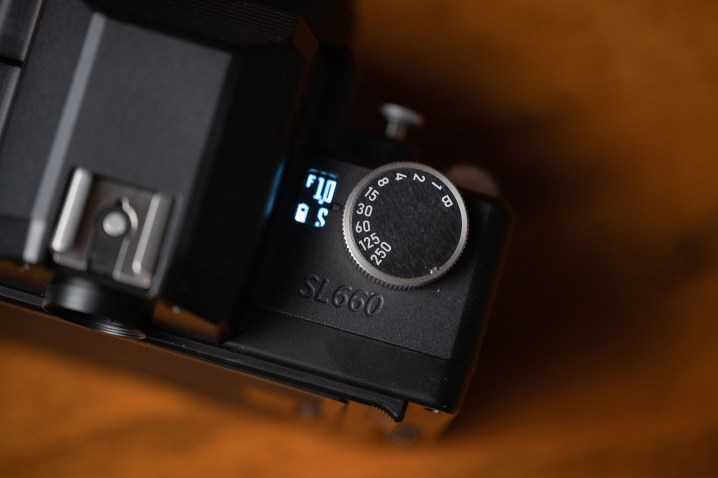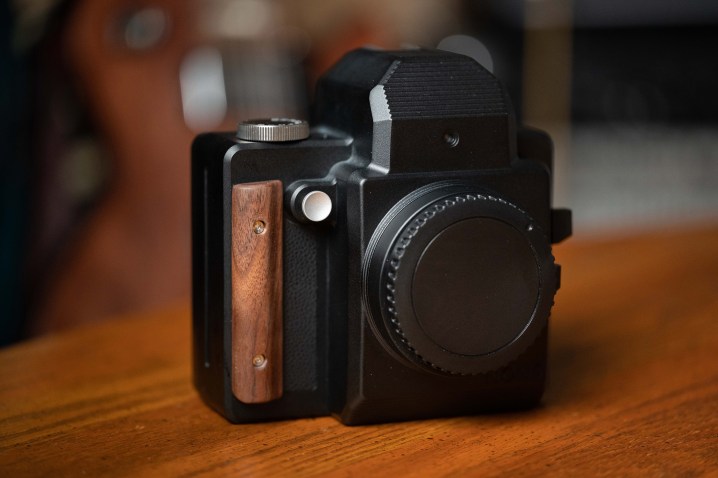Nons SL660 review: the magical film camera I fell in love with

“The Nons SL660 delivers a rewarding analog photography experience and beautiful images with retro charm.”
The pros
- Interchangeable lenses
- Excellent build quality
- Film photography is accessible
- It’s fun to use
- Beautiful images delivered in unique ways
Cons
- Film can be expensive
- It can be difficult to get the right focus and exposure.
Nons SL660 was the product of a successful Kickstarter campaign and is now a real thing. The Nons SL660 camera combines the best features of instax cameras with premium quality build and flexibility through an interchangeable lens system.
As someone who grew up as a digital photographer, I’ve always envied the physicality of film, and have regretted that so many of my images are trapped on hard drives and memory cards. The hassle of printing at home can make it difficult and the cost of ordering prints can prove costly. However, if you’re shooting rolls of film, then you’ve either got to develop it yourself or send it off to be printed. That’s where instant film comes in, and it offers an alternative that combines the immediacy of digital with the physical nature of film, while sidestepping the difficulties associated with actually getting your work printed.
Operation and design of the SL660 are not available
The SL660 is a chunky beast of a camera, but while it may be the size of a DSLR, it’s nowhere near as heavy to lug around. That’s because a film camera doesn’t need the heaps of electronics that are crammed inside your average digital camera, nor does it require a great big lithium-ion battery (though it does have a small one built-in). That’s not to say that it’s cheaply made, and in fact, it’s one of the more solidly built cameras I’ve used. This is an improvement on the plastic-clad exteriors found in many modern cameras.
The controls may seem a bit alien to those more used to digital cameras, but it’s really quite straightforward. For film cartridges, the back hatch can be opened. The lever on the left of the lens engages and arm the mirror to allow for photo taking. You’ll want to wait to press this until you have identified the scene you’re going to shoot — otherwise, you may accidentally trigger the shutter. The shutter button is located to the right of the lens and operates as any camera’s shutter button would.

You will find a small LCD screen and a cold-shoe mount to attach various accessories. The screen shows the remaining film in your cartridge, battery life, and the light meter. The light meter measures the amount of light in your direction and will tell you the F-stop you should use to expose the lens. It is recommended to use fully manual lenses that have mechanical apertures. This can be done via the dial located on the lens.
It can be used with electronic aperture lens by mounting the lens to a digital camera and setting the aperture. Then, detach the lens from the SL660. After the aperture is adjusted using the digital camera, the electronic lens retains the pre-set aperture. While this is an effective workaround, it’s certainly something of a hassle.

You will find the USB-C charger port, power switch and the film ejector button on the backside of the SL660. Simply press the film eject butt and the SL660 will spit out your photo to the side. This will allow you to wait for the development time. The exposed USB-C port in this camera and all the other unsealed openings make it difficult to use even in very low precipitation.
With the Nons 35mm f/2.4 lens, I tried the SL660. There is also a 50mm f/1.8 lens available. Also, adapters are available for many lens mounts including Pentax K and M42.
Image quality and performance of Nons SL660
It would not be fair or productive to grade the SL660 based on images quality based upon the standard metrics of sharpness, contrast and other elements that are essential for modern digital cameras. The Fujifilm Instax Square square film is what determines the SL660’s imaging performance. This film isn’t high resolution, has very poor dynamic range, and a rather high ISO of 800. The camera also uses an integrated optical to convert 35mm lenses to square format film. It also has a shutter speed of 1/250 which is very slow.
The upshot is that the SL660 is best used in low-contrast situations, and if you want to use wide-open aperture settings for glorious swirly bokeh, you’ll either need to shoot in dim lighting or use neutral density filters to darken the scene. Also, because of the nature of the film and the integrated lens system of the camera, don’t expect razor-sharp images out of the SL660.
When you are working together with the camera, all of the apparent difficulties can be transformed into artistic elements.
This is important to understand because the SL660 camera requires that you become intimately acquainted with all its flaws. When you are at ease with the camera, all of its problems can be transformed into creative elements.
The SL660 produces photos with a dreamy and aged look that I find evocative of a sense nostalgia. There’s also something really magical about seeing an image appear on paper in the moment after you’ve captured it. A digital image of an Instax print, along with the photo’s location in the background is a compelling topic for sharing via social media.
Performance nons SL660

The SL660 was a great camera mechanically. The controls feel very natural and are easy to use. I also find the sound effects from shooting photos extremely enjoyable. A minor issue for me is that the built-in light meter seems a little unreliable, though that’s most likely due to my inexperience with light meters. It is best to position the camera in different locations throughout the scene you intend to photograph. That helps me decide which settings are most effective. Due to its small size, I had difficulty focusing the camera accurately.
In regard to battery life, I received the camera partly charged, and didn’t bother to charge it before shooting. At the time of writing, around 30 photos have been taken. I also accidentally left it on multiple times. It shuts down automatically after 10 minutes and hasn’t noticedably run out of battery. Depending on how much you shoot, your experience may vary, but based on how I’ve been using the camera, I would be surprised if I needed to charge it once every three months.
Price and availability for Nons SL660

Starting at $600, the SL660 isn’t cheap. For $50 the 50mm F/1.8, and $110 for the 35mm F/2.4, you can purchase a lens. A modern digital camera with more detail can be purchased for the same price. For $200 you can get a Fujifilm Instax Mini Evo, which captures digital photos as well as acts like a wireless Instax printer. However, the SL660 provides an experience that digital can’t replicate, and it’s a much higher-quality option with greater versatility than inexpensive Instax cameras.
Instax Backs can be used to convert professional medium format cameras into instant film. This will deliver higher-quality images and a better shooting experience than the SL660, but there you’re looking at spending hundreds of dollars for the back, body, and lens, potentially landing you well over $1,000. The biggest problem with the SL660? It requires Instax Square film, which costs $20 per pack. Each cartridge contains 10 images. That means every time you click the shutter, you’re spending $1, and that’s particularly painful when you’re learning to use the camera and are making a lot of mistakes.
Nons SL660 is a top-end instant film machine that offers a unique experience.

The Nons SL660 was fantastic to use. The experience has shown me the pleasures of using film and how to get physical copies of images that I have captured. Digital cameras are easy to use, so there’s no incentive for me to think first. Once I have downloaded the images, they may be gone forever. I am able to take my time and compose every shot with the SL660. Once I have printed the images, I enjoy flipping through them often and thoroughly enjoying them.
It is an excellent camera to create art with and capture lasting memories without the confines of your computer’s hard drive. The SL660 is a great camera for capturing moments that I want to cherish, even if you are a professional photographer like me. It’s not perfect by any means, but those flaws count more as character than cons. The only really unfortunate aspect of this camera is that the film it requires is so expensive, but that’s beyond the control of Nons.
If you love photography and are looking for an exciting new experience to inspire you and help you hone your skills, then the Nons SL660 is what you’re looking for.
Editors’ recommendations